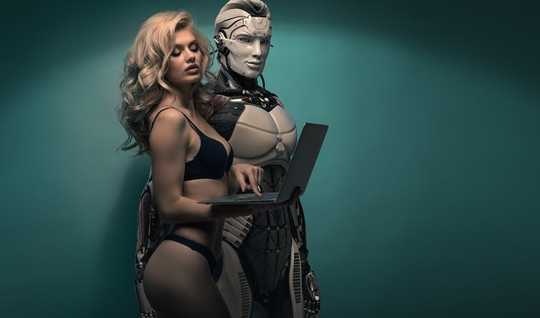 Advances in sex robots and technologies have applications in health care, education and research. Shutterstock
Advances in sex robots and technologies have applications in health care, education and research. Shutterstock
Science fiction films such as Blade Runner (1982), Lars and the Real Girl (2007) and Her (2013) explore the advent of human-machine relationships. And in recent years, reality has met fiction.
Powered by advancements in artificial intelligence (AI) and social robotics, artificial social agents are learning to communicate, learn and socialize, transforming our societies. Yet research on human-machine interaction is still in its early stages, particularly in the areas of intimacy and sexuality.
In addition to our research on the topic, we have also been involved in spearheading initiatives to remedy the lack of knowledge on intimate human-machine relationships. In this spirit, we organized the first colloquium on erobotics at the 87th Annual Congress of the Association Francophone pour le Savoir. There, researchers discussed various themes ranging from media and gender representations of sexual technologies to their medical and therapeutic potential.
A new erotic revolution
Interestingly, intimacy and sexuality may just be some of the most important areas to consider when it comes to the AI revolution, because new advanced technologies increase the possibilities of human interaction with artificial erotic agents or erobots.
The term erobot characterizes all virtual, embodied and augmented artificial erotic agents, as well as the technologies that produce them. This definition includes — but is not limited to — prototypes of sex robots, virtual or augmented erotic characters, artificial partner applications and erotic chatbots. The word erobot is a portmanteau of erôs (a historically rich philosophical concept referring to love, desire, sensuality and sexuality, bot (a software agent), and robot (a machine capable of autonomously performing complex series of actions). The term erobot is meant to emphasize the agential and relational aspects of new erotic technologies and highlight the fact that artificial agents are becoming social actors in their own right.
More than sex robots
One of the most (in)famous type of erobot is the human-like sex robot. However, sex robots represent only a fraction of what erobots are and can be as a result of the advancement, combination and the interconnectivity of new technologies. For example, progress made in conversational agents (programs that interprets and responds to users in ordinary natural languages), soft robotics (a field that constructs robots similar to living organisms), cloud computing and virtual and augmented reality will increasingly expose humans to new kinds of erotic partners.
These partners will be able to manifest themselves through various interfaces such as cellphones, computers, gaming consoles and virtual reality equipment. They will be able to take a variety of forms and enact unlimited behaviours in simulated worlds. The ability to think and learn in fundamentally different ways than humans will allow for a wide new range of intimate human-machine relationships, redefining what it means to fall in love and have sex with artificial beings.
In the 2013 film Her, the protagonist develops a relationship with his operating system.
{vembed Y=ne6p6MfLBxc}
And that, in itself, should be considered an erotic revolution. It is also the ground for the creation of a new research field called Erobotics.
The study of human-erobot interactions
Erobotics is an emerging field of transdisciplinary research exploring our interaction with artificial erotic agents, as well as the technology that produces them. Erobotics focuses on the social, relational and agential aspects of artifical agents and the fact that we increasingly treat them as social actors in their own rights.
Not only the use of advanced technology in sex and relationship, but the artificial erotic beings that emerge from these kinds of technologies.
Erobotics develops theoretical, experimental and clinical research methods to study all phenomena related to human-erobot interactions. The field is interested in questions such as: What kinds of relationships will we develop with artificial agents? How will erobots transform our erotic minds and behaviors and influence our relationships? What regulations should be implemented regarding erobots?
As it has been suggested regarding the employment of sex toys, dolls, and robots, Erobotics operates under sexuality and technology positive frameworks. This means that Erobotics emphasizes the importance of pleasure, freedom and diversity. Erobotics also aims to develop technologies that improve our well-being and guide the development of artificial erotic agents. Moreover, Erobotics is concerned with the ethical and social implications of erobots: for instance, who should be allowed to interact with erobots, what forms and behaviors should be possible and how will they transform our social norms regarding sexuality and intimacy?
Future applications of erobots
Erobots could have applications in health, education and research.
Erobots could be used for individuals who have trouble finding partners, who may prefer artificial agents or simply want to experience pleasure. Erobots could also be used in medical and therapeutic settings to help with intimacy-related fears and anxiety or to help trauma victims get reacquainted with their body and sexuality.
Erobots could be employed for exploration and practice to help people discover their erotic preferences. They could also be developed to provide validated interactive sex education and help people learn about respect, consent, diversity and mutuality in an innovative way.
Erobots could be used as standardized research tools to help researchers overcome ethical and methodological challenges related to sensitive research programs. They could act as both stimuli and recording instrument in research protocols and reduce risks associated with human-human erotic interactions.
 Erobotics incorporates a positive sexuality approach, exploring questions that include other ethical and regulatory approaches to human-technology interactions. Shutterstock
Erobotics incorporates a positive sexuality approach, exploring questions that include other ethical and regulatory approaches to human-technology interactions. Shutterstock
Transdisciplinary futures
But ultimately, to harness erobots’ potential, we must build transdisciplinary collaborations to tackle the complex phenomena related to erobotics. This means bringing inputs from across disciplines — from computer engineering and programming to social sciences and humanities — as well as bridging academia and the private sector.
A collaborative future is the key to develop erobots that contribute to our individual and collective well-being.![]()
About The Author
Simon Dubé, PhD student, Concordia University and Dave Anctil, Chercheur affilié à l'Observatoire international sur les impacts sociétaux de l’intelligence artificielle et du numérique (OIISAN), Université Laval
This article is republished from The Conversation under a Creative Commons license. Read the original article.

Related Books:
Come as You Are: The Surprising New Science That Will Transform Your Sex Life
by Emily Nagoski
A groundbreaking book about why sex is so important to us, and what science is revealing about how we can make our sex lives better.Click for more info or to order
She Comes First: The Thinking Man's Guide to Pleasuring a Woman
by Ian Kerner
A guide to giving and receiving better oral sex, with an emphasis on female pleasure and satisfaction.Click for more info or to order
The Joy of Sex: The Ultimate Revised Edition
by Alex Comfort
A classic guide to sexual pleasure, updated and expanded for the modern era.Click for more info or to order
The Guide to Getting It On! (The Universe's Coolest and Most Informative Book About Sex)
by Paul Joannides
An entertaining and informative guide to sex, covering everything from anatomy and technique to communication and consent.Click for more info or to order
The Erotic Mind: Unlocking the Inner Sources of Sexual Passion and Fulfillment
by Jack Morin
An exploration of the psychological and emotional aspects of sexuality, and how we can develop a healthier and more fulfilling relationship with our own desires.























